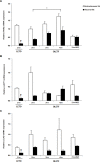Depot-Specific Changes in Fat Metabolism with Aging in a Type 2 Diabetic Animal Model
- PMID: 26894429
- PMCID: PMC4760935
- DOI: 10.1371/journal.pone.0148141
Depot-Specific Changes in Fat Metabolism with Aging in a Type 2 Diabetic Animal Model
Abstract
Visceral fat accretion is a hallmark of aging and is associated with aging-induced metabolic dysfunction. PPARγ agonist was reported to improve insulin sensitivity by redistributing fat from visceral fat to subcutaneous fat. The purpose of this study was to investigate the underlying mechanisms by which aging affects adipose tissue remodeling in a type 2 diabetic animal model and through which PPARγ activation modulates aging-related fat tissue distribution. At the ages of 21, 31 and 43 weeks, OLETF rats as an animal model of type 2 diabetes were evaluated for aging-related effects on adipose tissue metabolism in subcutaneous and visceral fat depots. During aging, the ratio of visceral fat weight to subcutaneous fat weight (V/S ratio) increased. Aging significantly increased the mRNA expression of genes involved in lipogenesis such as lipoprotein lipase, fatty acid binding protein aP2, lipin 1, and diacylglycerol acyltransferase 1, which were more prominent in visceral fat than subcutaneous fat. The mRNA expression of adipose triglyceride lipase, which is involved in basal lipolysis and fatty acid recycling, was also increased, more in visceral fat compared to subcutaneous fat during aging. The mRNA levels of the genes associated with lipid oxidation were increased, whereas the mRNA levels of genes associated with energy expenditure showed no significant change during aging. PPARγ agonist treatment in OLETF rats resulted in fat redistribution with a decreasing V/S ratio and improved glucose intolerance. The genes involved in lipogenesis decreased in visceral fat of the PPARγ agonist-treated rats. During aging, fat distribution was changed by stimulating lipid uptake and esterification in visceral fat rather than subcutaneous fat, and by altering the lipid oxidation.
Conflict of interest statement
Figures




Similar articles
-
Mechanisms of the depot specificity of peroxisome proliferator-activated receptor gamma action on adipose tissue metabolism.Diabetes. 2006 Oct;55(10):2771-8. doi: 10.2337/db06-0551. Diabetes. 2006. PMID: 17003342
-
Peroxisome proliferator-activated receptor γ activation favours selective subcutaneous lipid deposition by coordinately regulating lipoprotein lipase modulators, fatty acid transporters and lipogenic enzymes.Acta Physiol (Oxf). 2016 Jul;217(3):227-39. doi: 10.1111/apha.12665. Epub 2016 Mar 12. Acta Physiol (Oxf). 2016. PMID: 26918671
-
Depot-specific regulation of perilipin by rosiglitazone in a diabetic animal model.Metabolism. 2007 May;56(5):676-85. doi: 10.1016/j.metabol.2006.12.017. Metabolism. 2007. PMID: 17445544
-
Energy Metabolism Changes and Dysregulated Lipid Metabolism in Postmenopausal Women.Nutrients. 2021 Dec 20;13(12):4556. doi: 10.3390/nu13124556. Nutrients. 2021. PMID: 34960109 Free PMC article. Review.
-
Gender differences in fat metabolism.Curr Opin Clin Nutr Metab Care. 2001 Nov;4(6):499-502. doi: 10.1097/00075197-200111000-00006. Curr Opin Clin Nutr Metab Care. 2001. PMID: 11706283 Review.
Cited by
-
Association of epicardial adipose tissue with metabolic risk factors on cardiovascular outcomes: serial coronary computed tomography angiography study.Korean J Intern Med. 2024 Mar;39(2):283-294. doi: 10.3904/kjim.2023.389. Epub 2024 Feb 14. Korean J Intern Med. 2024. PMID: 38351679 Free PMC article.
-
Adipose Tissue Aging and Metabolic Disorder, and the Impact of Nutritional Interventions.Nutrients. 2022 Jul 29;14(15):3134. doi: 10.3390/nu14153134. Nutrients. 2022. PMID: 35956309 Free PMC article. Review.
-
Metformin alleviates stress-induced cellular senescence of aging human adipose stromal cells and the ensuing adipocyte dysfunction.Elife. 2021 Sep 21;10:e62635. doi: 10.7554/eLife.62635. Elife. 2021. PMID: 34544550 Free PMC article.
-
Life-span Extension Drug Interventions Affect Adipose Tissue Inflammation in Aging.J Gerontol A Biol Sci Med Sci. 2020 Jan 1;75(1):89-98. doi: 10.1093/gerona/glz177. J Gerontol A Biol Sci Med Sci. 2020. PMID: 31353414 Free PMC article.
-
Exposure to Volatile Organic Compounds in Relation to Visceral Adiposity Index and Lipid Accumulation Product Among U.S. Adults: NHANES 2011-2018.Toxics. 2025 Jan 9;13(1):46. doi: 10.3390/toxics13010046. Toxics. 2025. PMID: 39853044 Free PMC article.
References
-
- Guo SS, Zeller C, Chumlea WC, Siervogel RM (1999) Aging, body composition, and lifestyle: the Fels Longitudinal Study. Am J Clin Nutr 70: 405–411. - PubMed
-
- Zamboni M, Armellini F, Harris T, Turcato E, Micciolo R, et al. (1997) Effects of age on body fat distribution and cardiovascular risk factors in women. Am J Clin Nutr 66: 111–115. - PubMed
-
- DeNino WF, Tchernof A, Dionne IJ, Toth MJ, Ades PA, et al. (2001) Contribution of abdominal adiposity to age-related differences in insulin sensitivity and plasma lipids in healthy nonobese women. Diabetes Care 24: 925–932. - PubMed
-
- Hughes VA, Roubenoff R, Wood M, Frontera WR, Evans WJ, et al. (2004) Anthropometric assessment of 10-y changes in body composition in the elderly. Am J Clin Nutr 80: 475–482. - PubMed
Publication types
MeSH terms
Substances
LinkOut - more resources
Full Text Sources
Other Literature Sources
Medical
Research Materials

